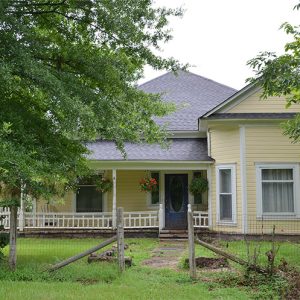calsfoundation@cals.org
Thomas L. Hodges (1868–1953)
Thomas Luther Hodges was a noted physician and amateur archaeologist in Hot Spring County in the early twentieth century. Focusing on materials related to the late prehistoric Caddo, the collection accumulated by Hodges and his wife, Charlotte, is now held by the Joint Educational Consortium in Arkadelphia (Clark County).
Thomas L. Hodges was born in Morehead, Kentucky, on January 17, 1868. It is unclear what happened to Hodges’s birth parents, but he became the adopted son of William and Sarah Hodges and moved with his adoptive family to Knox County, Missouri, in the early 1870s. His father died in 1874, and Sarah Hodges remarried the following year to widower George Sloan. In the 1880 federal census, Hodges appears with his stepfather’s family, including four stepsiblings.
Much of Hodges’s early life before he moved to Arkansas is unknown. He married Lillie Wilson, and the couple had a son, Thomas Earl Hodges, in 1891, who died from cancer in 1916 and is buried in La Belle, Missouri. It is unknown what happened to Lillie, but the marriage apparently did not continue.
Hodges attended medical school at Barnes Medical College in St. Louis, Missouri, and graduated in 1899 at the age of thirty-one. He married a woman named Mary. The couple resided in St. Louis, and Hodges worked as a general practice physician. This marriage also ended.
Charlotte Mikulus, who would become Hodges’s third wife, was a native of Europe who immigrated with her parents to the United States shortly after the turn of the century. Born in Slovenia, Mikulus grew up in Missouri. She graduated from Washington University in St. Louis in 1922 and began working as a chemist for the John T. Milliken and Company, producing medicines. She married Hodges in 1927. The couple had two children: Lois Hodges Canfield and Thomas Valentin Hodges.
The couple settled in Bismarck (Hot Spring County) shortly after their marriage and remained in the area until their deaths. In addition to their role in the community as healthcare providers, the couple conducted extensive research on the Native American cultures that existed in the area.
The Hodgeses’ interest in Native Americans led to extensive excavations at several sites in Hot Spring and Clark counties. These locations include the Hardin Mound south of Arkadelphia, a large Caddoan mound near Friendship (Hot Spring County), and multiple sites on Watermelon Island, located on the Ouachita River near Midway (Hot Spring County). The research at Watermelon Island led to the publication of an article written by the couple in 1943, with a second article appearing in 1945. Both were published in the Texas Archeological and Paleontological Society Bulletin and later reprinted in the Arkansas Archeological Society Bulletin.
Arkadelphia residents Robert Proctor, Vere Huddleston, Richard Reid, and Charlie Richardson worked with the Hodgeses to identify and gather objects uncovered in the area. Thomas Hodges worked with local residents who uncovered artifacts on their land, typically while farming, and added the items to his collection. After the death of Huddleston in 1946, the Hodgeses acquired his collection, including the notebooks used to note the locations where each artifact originated. The Hodgeses likewise took extensive notes on the artifacts they acquired, adding important documentation to their growing collection. Eventually, the collection totaled more than 55,000 artifacts. The bulk of the items were stored in a small building behind the Hodgeses’ home in Bismarck.
In addition to their active efforts in the field, the Hodgeses also worked with academic archaeologists to share what they learned. Archaeologists from the University of Arkansas (UA) in Fayetteville (Washington County), the University of Texas, and Harvard University worked with the Hodgeses to learn about the Caddo culture. Both of the Hodgeses helped organize the Arkansas Archeological Society, with Thomas serving as the first president and Charlotte as an assistant editor of the journal. Sam Dellinger served as the vice president. This group operated for only a short period. Both Thomas and Charlotte were charter members of the Arkansas Historical Association in 1942.
The Hodgeses also played an important role in the preservation of a Quapaw site in eastern Arkansas. Located at the southern end of the Grand Prairie, the site is in present-day Arkansas County and known as the Menard-Hodges Site. The Hodgeses purchased the land in 1941, and Charlotte Hodges sold the land to the Archeological Conservancy in 1980. Added to the National Register of Historic Places in 1985 and named a National Historic Landmark in 1989, the site became part of Arkansas Post National Memorial.
The collection built by the Hodgeses was acquired in 1977 by the Joint Educational Consortium, a nonprofit organization sponsored by Henderson State University and Ouachita Baptist University. The collection is curated by the Arkansas Archeological Survey station located at Henderson and is housed in the Caddo Center, the former cafeteria on the Henderson campus.
Thomas Hodges died on December 3, 1953, and Charlotte Hodges died on February 13, 1994; both are buried in the Bismarck Cemetery. The Hodges House in Bismarck is listed on the National Register of Historic Places.
For additional information:
Early, Ann. “Dr. Thomas L. Hodges and His Contribution to Arkansas Archeology.” Arkansas Archeologist (1986): 1–9.
Hodges, T. L., and Charlotte Hodges. “Jean Lafitte and Major L. Latour in Arkansas Territory.” Arkansas Historical Quarterly 7 (Winter 1948): 237–256.
———. “Possibilities for the Archaeologist and Historian in Eastern Arkansas.” Arkansas Historical Quarterly 2 (June 1943): 141–163.
———. “Suggestion for Identification of Certain Mid-Ouachita Pottery as Cahinnio Caddo.” Bulletin of the Texas Archeological and Paleontological Society 16 (1945): 98–116.
———. “The Watermelon Island Site in Arkansas.” Texas Archaeological and Paleontological Society Bulletin 15 (1943): 9–16.
Trubitt, Mary Beth. “Documenting Caddo Pottery: The JEC Hodges Collection.” Arkansas Archeological Survey, Henderson State University Research Station, https://archeology.uark.edu/learn-discover/current-research/hodges10/ (accessed August 30, 2023).
———. “Documenting the Hodges Collection: Pottery from Five Ouachita River Valley Sites.” Caddo Archaeology Journal 33 (2023): 5–160.
Trubitt, Mary B., and Linda Evans. “Revisiting a Historic Manuscript: Vere Huddleston’s Report on East Place (3CL21) Excavations.” Caddo Archaeology Journal 25 (2015): 73–144.
David Sesser
Southeastern Louisiana University
 Early Twentieth Century, 1901 through 1940
Early Twentieth Century, 1901 through 1940 Health and Medicine
Health and Medicine Hodges House
Hodges House 




Comments
No comments on this entry yet.